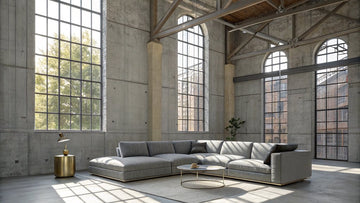Room layout and building design play a key role in picking the right furniture. The size of rooms and how tall the ceilings are help determine what furniture fits best. Windows tell us where to put pieces to get good daylight, while the style of the building - whether old-fashioned or new - guides what materials work well. We need to think about how people move through spaces when placing furniture. When we pay attention to these building features, we can create rooms where everything fits together nicely.
Key Takeaways
- Ceiling height directly determines appropriate furniture height to maintain visual balance and prevent cramped spaces.
- Window placement influences furniture arrangement to maximize natural light and create functional seating areas.
- Support posts and overhead beams restrict furniture size and placement options within the room layout.
- Building materials and architectural style should guide furniture material choices for visual cohesion and design harmony.
- Room dimensions and scale dictate appropriate furniture proportions to ensure comfortable flow and functionality.
Spatial Dynamics and Furniture Proportions
The balance between room layouts and furniture sizes is key to creating spaces that work well and look good together. When designing a room, every piece of furniture needs to fit properly with the building's features, making sure nothing looks out of place or too big or small.
In rooms without walls between areas, the size and placement of furniture helps create separate spaces while keeping the room easy to move through. For those dealing with limited square footage, space-saving solutions for compact lounges can help maximize functionality without compromising style. Furniture must be arranged carefully around windows to let in plenty of light and make walking paths clear.
When rooms have low ceilings, it's important to choose furniture that doesn't make the space feel cramped. Room features like support posts and overhead beams help determine what furniture sizes work best. When all these pieces fit together well, the room becomes both useful and pleasing to look at.
Natural Light Considerations in Furniture Selection
Natural light changes how furniture looks and works in a room, making it important to think about when choosing and placing pieces. Window locations help determine where furniture should go, as shiny surfaces need careful placement to avoid unwanted glare while keeping the room easy to use.
Today's furniture often uses see-through materials, which helps bring more daylight into living spaces and supports eco-friendly living. When picking furniture colors and fabrics, consider the room's natural light - light colors make bright rooms feel even brighter, while dark colors help balance rooms that don't get much sun.
Placing furniture near windows creates interesting focal points and reduces the need for electric lights, helping the room's layout work well with the building's design.
Flow Patterns and Strategic Placement
The way furniture is placed affects how people walk through and use rooms, making movement patterns very important when designing spaces. Smart furniture setup creates different areas while keeping them well-connected, helping people find their way around naturally.
To make spaces work well, designers focus on:
- Watching how people walk to place furniture that guides them without getting in their way.
- Making open areas that work for both group activities and quiet time.
- Building clear walking paths between different areas while keeping the room looking good.
- Putting furniture where it fits well with walls, windows, and doors to use space wisely.
Smart furniture placement makes rooms work better and look better, ensuring pieces fit naturally with how people move while keeping spaces easy to use and comfortable. For entertainment-focused areas, understanding lounge furniture arrangement for entertainment spaces becomes particularly crucial.
Material Harmony Between Structure and Furnishings
Choosing the right furniture for a space means making sure it fits well with the building's materials and design. The way furniture materials work with the building's features helps create a complete and unified look. This match becomes especially important in rooms where the building itself has strong design elements.
Natural materials help link the building and its furniture together. For example, old wood and stone pieces work perfectly in spaces with a rustic feel. In modern buildings, furniture made of metal and glass matches the building's up-to-date style.
Good furniture picks also think about the environment, using recycled materials that look good and help protect nature. The fabrics used on furniture also need to match the space - soft materials work best in cozy rooms, while smooth, clean materials suit simple, modern spaces.
Scale Relationships in Room Design
Furniture choices depend heavily on the size and shape of a room. When furniture and room features work well together, they create a pleasing look that makes sense to the eye.
To make furniture and rooms work well together:
- The height of your ceilings affects how tall your furniture should be - from bookcases to hanging lights.
- The size of your room determines furniture layout - bigger rooms need bigger pieces to look right.
- Small spaces work best with furniture that can serve multiple purposes or be easily moved around.
- Room features like archways, support columns, and built-in shelves help decide where furniture should go for good traffic flow.
When you match furniture size to room size, everything fits together naturally. Understanding perfect proportions and mastering scale in bedroom design can help achieve this balance throughout your home.
This creates rooms that look well-planned and comfortable, where no single piece stands out in a jarring way.
Architectural Style Integration
Picking the right furniture starts with looking at how a building is designed. Every building style needs its own approach to furniture selection to make the whole space work well together.
Buildings with modern design work best with simple, straight-edged furniture that matches their basic look, while older buildings with fancy details need furniture that fits their decorative style.
In factory-style spaces, furniture with raw, natural finishes works well with the exposed beams and pipes. In spaces with few walls, furniture helps create separate areas while keeping the space easy to move through. For homes with flowing layouts, creating zones in open-plan living areas provides valuable strategies for defining spaces. In buildings that mix different styles, blending new and old furniture pieces can work nicely with the various building features.
Multi-functional Solutions for Complex Spaces
Today's buildings need furniture that can do many jobs while fitting into tight spaces. In small homes, smart designs blend good looks with usefulness, creating rooms that work for different tasks.
To make the most of space, focus on:
- Furniture that changes its job, like couches that turn into beds and pieces that can be taken apart and rebuilt.
- Built-in tech features like phone chargers and ways to connect devices.
- Comfortable pieces that support people's bodies well as they move and work.
- Careful placement that works with room features like tall ceilings and walking paths.
These choices show how picking the right furniture can help rooms work better while staying beautiful and comfy. Multifunctional furniture for flexible living spaces offers innovative solutions for maximizing utility in any room.
When each piece of furniture can do many jobs, even small spaces become more useful.
Sustainable Design Elements and Furniture Choices
The smart use of sustainable design shapes how we choose furniture in today's buildings. Using old wood and recycled materials creates earth-friendly options that work well in green spaces.
Safe, non-toxic finishes and green building practices help pick furniture that keeps indoor air clean while looking good.
Modern spaces now favor furniture that serves many purposes, doing more with less material. Using materials from nearby sources helps furniture work better with building features while helping the environment.
Strong, lasting design is key when picking sustainable furniture, making sure pieces stay useful and attractive for many years. These well-chosen pieces not only match green building features but also help create safer, cleaner living spaces that are better for our planet.
Frequently Asked Questions
Why Are Architectural Features Important?
The way a building is designed matters both for how it stands up and how it looks. Key building parts work together to make spaces feel right and work well. These features tell us about the times when they were built, help rooms connect naturally, control how light moves through spaces, and mix different building materials. All of these elements come together to give a building its unique feel and make it useful for the people who use it.
Why Is Design Important in Furniture?
Good furniture design brings together comfort, looks, and the right materials to make spaces work better. It helps create rooms that look good together through matching colors and styles, while also respecting different cultural traditions. When done well, design makes our living spaces both beautiful and useful.
Is Interior Design Influenced by Architectural Styles?
Interior design strongly connects with building styles in many ways. Modern and historical building designs shape how we create indoor spaces. When designers plan rooms, they consider how the building's structure, style, and purpose work together. They choose materials and designs that match the building's character, making spaces that feel complete and well-planned. The way rooms flow and function depends on the building's architecture, creating spaces that make sense for how people use them.
What Are the Factors That Influence the Choice of Architectural Style and Structure?
The choice of how a building looks and stands depends on many things: today's design trends, the area's past, local building styles, cultural meaning, how the building will be used, eco-friendly options, and how much money can be spent. All these pieces work together to shape what gets built and how it's made.
Conclusion
Architectural features play a key role in choosing the right furniture, creating a natural connection between a building's structure and its interior pieces. At Timbur, we've seen how room layouts, lighting, traffic patterns, and materials all work together to shape furniture decisions. When these elements match well, they create spaces that look good and work perfectly. By picking the right size, style, and eco-friendly pieces, rooms become complete spaces where building features and furniture blend seamlessly to create beautiful, practical environments. Our handcrafted furniture pieces are designed with these architectural considerations in mind, ensuring they enhance any space they occupy.









